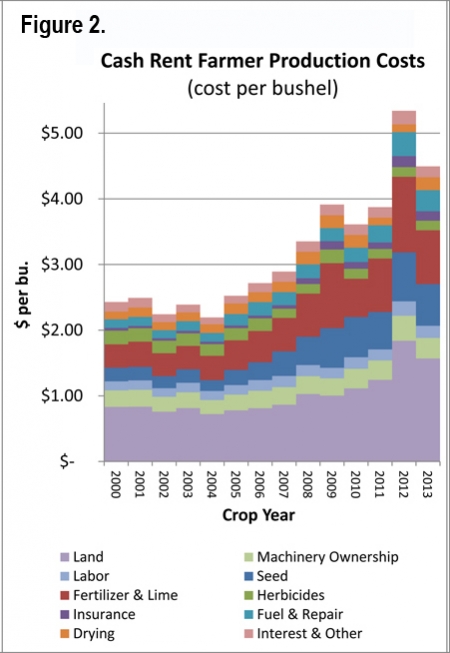Corn farmers will soon be planting the most expensive crop ever put in the ground, while they are watching the price of corn to see if it will recover from the $1.10 drop in the past week. After all, such a drop in price could push it below the cost of production for many farmers. With higher input costs and lower commodity prices, many farmers will find themselves in a cost-price squeeze for the 2013 crop.
The cost-price squeeze is laid out in basic numbers by Iowa State University economist Don Hofstrand. While Hofstrand says his data is effective for farmers in the State of Iowa, it is also effective for many farmers around the Cornbelt. About the only variable is land cost in the form of cash rent, and Hofstrand’s example uses lower cash rent than many farmers have agreed to pay to land owners.
Higher Production Costs
- Production inputs include seed, fertilizers, herbicides diesel fuel, and others. For 2013 per acre costs he is using $109 for seed corn, $145 for fertilizer and lime, $25 for herbicide, $25 for crop insurance, $55 for fuel and repairs, $34 for grain drying, $32 for labor, $29 for interest and other costs.
- The second is the cost of machinery ownership. These costs are depreciation (an estimate of actual deprecation, not tax depreciation) and interest payments on machinery debt. Hofstrand uses $54 per acre for machinery costs.
- The third is the cost of cropland. The annual cost of cropland is estimated using the cash rental rate. By charging a land cost equal to the cash rental rate, the return for producing corn is the return to the farm operator (does not includes the landlord’s return). Hofstrand uses a figure of $270 per acre for cash rent.
These costs were fairly static until 2004 until a major expansion of the ethanol industry. Hofstrand says in 2009, production costs spiked over $700 per acre and are expected to reach a $777 per acre average this year. He says cost per acre will vary per yield and yield will vary greatly depending on the year. In 2012 he says the drought pushed the cost per bushel to $5.38 per bushel, based on a 137 bushel average corn yield in his state of Iowa. Hofstrand says that number should fall to $4.52 per bushel in 2013, based on a normal yield of 172 bushels per acre. The $4.52 is calculated from $2.64 in total crop inputs, 31 cents for machinery ownership, and $1.57 per bushel for cash rent.

Higher Cost Per Acre
In addition to the cost per bushel calculation, Hofstrand also looks at the total cost of crop inputs, machinery ownership, and cash rent for planting and harvesting 500 acres of corn. That has risen from $175,000 in 2000 to $388,684 in 2013. The Iowa State economist says, “Although corn production costs have risen substantially in recent years, the cost per bushel has not exceeded selling price. If corn prices are above cost per bushel in coming years, production costs will continue to rise to fill the gap between cost and price. If production input costs don’t rise sufficiently to fill this gap, cash rental rates will fill it due to competition among farmers for farmland."
Hofstrand also addresses the cash rent level, which he says will go higher, helped by the crop insurance revenue payment levels, “The current generous revenue insurance program reduces the need for a risk premium in the profit structure of corn production, allowing corn farmers to bid cropland rents even higher. So, the higher corn prices generated by the corn ethanol industry are, or will soon be, fully capitalized into the corn farmer’s cost structure.”
Source: Farmgateblog
Click here to see more...